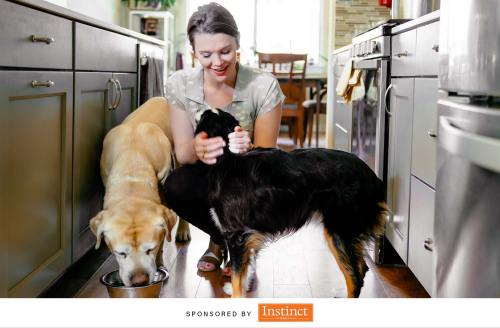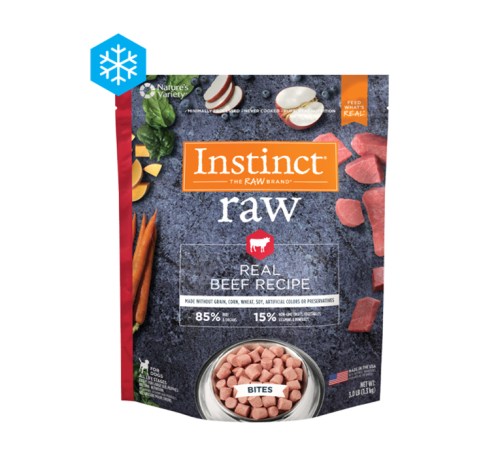advertisement
Okay, So the Science Behind Raw Pet Food Is Fascinating—And Makes a Strong Case for Switching Your Pet’s Food, Forever
There are plenty of benefits of raw dog food for your pet's health, and here a vet shares the research that makes the case for switching up your dog's diet.

When the wellness stars align, and the foods you crave are also really good for you, you usually add them into your regular meal rotation as often as possible, right?
You do this, we do this, and—stick with us here—if dogs could pick their own food, they’d do it, too. (Okay, fine, they’d probably go for a plate of brownies, but that’s why you’re in charge.)
Identifying the foods that are going to make your pups feel their best is exactly what veterinarian and research scientist Anna Hielm-Björkman, DVM, PhD, is doing with DogRisk, an independent research program that focuses on how genetic, nutritional, and environmental factors influence disease in dogs.
As part of DogRisk, Dr. Hielm-Björkman and team surveyed more than 16,000 dogs, collecting tons of data about what dogs were eating, where they were living, and how old they were when they contracted a disease.
The results were eye-opening (more on that later), and pointed to how raw dog food can be beneficial to canine health. In hopes of educating pet owners and veterinarians on the findings, Instinct® Pet Food is sponsoring Dr. Hielm-Björkman in this research. Identifying how to support dogs’ health, then sharing the results? Doesn’t sound like a bad idea.
Thinking about switching your pup? Keep scrolling for a look at the science behind raw dog food.
All about allergies
There are plenty of health benefits associated with feeding dogs a raw diet, but one study that came out of the DogRisk research found that puppies who were given raw dog food had fewer environmental allergies as adults than puppies who were fed processed kibble. The research also found evidence that feeding the mother a raw food diet before giving birth was associated with a lower chance of the puppies developing allergies later on.
The findings are major, because up to 27 percent of dogs have canine atopic dermatitis (CAD), which is a genetic hypersensitivity to environmental substances that can cause itching, excessive scratching, hot spots, greasy or flaky skin, hair loss, and excessive chewing on paws—aka, nothing you want your furry BFF to experience. Plus, Dr. Hielm-Björkman and her team are continuing their research into even more health benefits of a raw dog diet to see if it could help with GI issues, cancer, mobility issues, and more.
“Raw food is healthier because it contains thousands more bioactive factors than processed food, in which they have been destroyed by heat,” says Susan G. Wynn, DVM, DACVN, board-certified veterinary nutritionist™ and senior director of scientific affairs for Instinct®. “Many of these bioactives can reduce inflammation, and suppress damage to DNA.”
In short, raw food like Instinct® leaves the good nutrients intact so they can help support your pup’s health—which is good news when it comes to CAD, because it can be expensive to treat and doesn’t have a cure. The more you know.
Shop Raw Pet Food

Instinct Raw Real Beef Recipe

Instinct Raw Cage-free Chicken Recipe

Instinct Raw Grass-fed Lamb Recipe

Instinct Raw Signature Cage-free Chicken Recipe

Instinct Raw Signature Cage-free Duck Recipe

Instinct Raw Signature Grass-fed Beef Recipe
How it’s made
If you thought feeding your dog a raw diet meant just tossing a juicy steak in a bowl, think again. “Perhaps the biggest misconception [about raw dog food]—even among veterinarians—is that raw diets are all homemade, and therefore nutritionally unbalanced and full of harmful bacteria,” Dr. Wynn says. “Instinct®, at least, is nutritionally complete, and does not contain pathogens.”
For raw food to earn that nutritionally complete label, it has to pass way more tests than a homemade doggie dinner. The ingredients that go into Instinct® recipes are extensively analyzed before they’re formulated into recipes, Dr. Wynn says, and then the formulas are studied some more to ensure they’re including all the proper nutrients a dog needs, and leaving out any bacteria.
“Raw meat very often contains harmful bacteria that make dogs, cats, and the people who feed them sick,” Dr. Wynn says. (File that under “reasons not to feed your dog that raw steak.”) Instead of cooking it, commercial raw food often goes through high-pressure processing (like, bottom of the ocean levels of pressure, Dr. Wynn says) to remove any bad bacteria.
“Instinct® has a zero-tolerance policy for these harmful bacteria,” Dr. Wynn says. “If they are present after all of our safety steps, we don’t send the product out.” And that’s how raw is done.
How to transition your pup to raw dog food
If you want to get your dog on the raw train, there’s a few things to consider first. With any new diet (or habit, really) comes a transition period, and since dogs eat the same thing each day, it’s going to be a big change for them.
The first week, mix raw food with your dog’s usual food, and slowly increase the ratio. After about a week, you should be able to fill their bowl 100 percent with raw, and tell your pup to get ready for the best (and healthiest) dinner of their life.
Want more intel on the science behind raw dog food? Click here for even more of a deep dive into the research.
Sponsored by Instinct® Pet Food
Top photo: Getty Images/Inti St Clair
Sign Up for Our Daily Newsletter
Get all the latest in wellness, trends, food, fitness, beauty, and more delivered right to your inbox.
Got it, you've been added to our email list.




